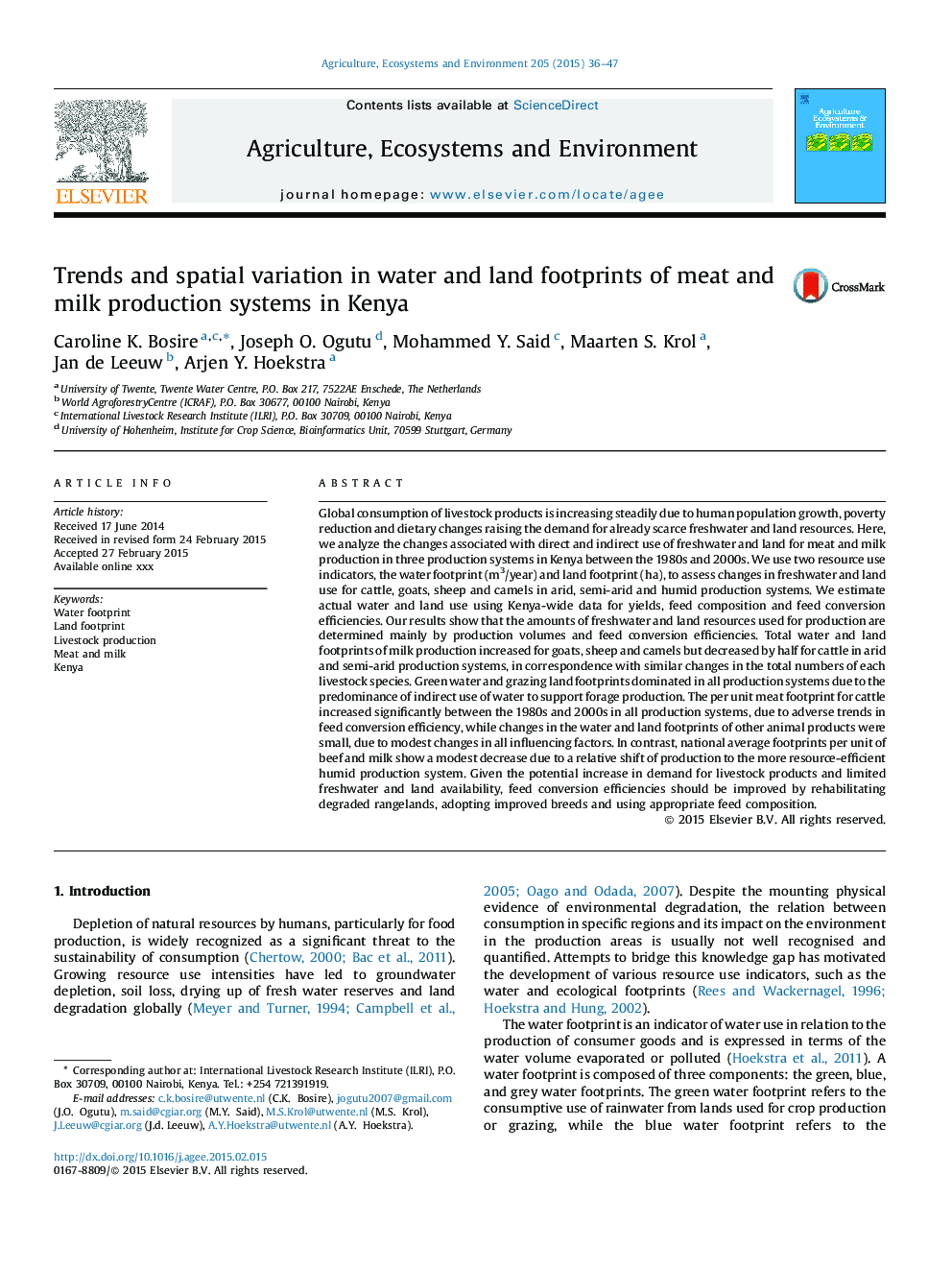| کد مقاله | کد نشریه | سال انتشار | مقاله انگلیسی | نسخه تمام متن |
|---|---|---|---|---|
| 8487743 | 1552047 | 2015 | 12 صفحه PDF | دانلود رایگان |
عنوان انگلیسی مقاله ISI
Trends and spatial variation in water and land footprints of meat and milk production systems in Kenya
ترجمه فارسی عنوان
روند و تنوع فضاهای موجود در آب و زمین سیستم های تولید گوشت و شیر در کنیا
دانلود مقاله + سفارش ترجمه
دانلود مقاله ISI انگلیسی
رایگان برای ایرانیان
کلمات کلیدی
رد پای آب رد پای زمین، تولید دام، گوشت و شیر، کنیا،
ترجمه چکیده
مصرف جهانی محصولات دام به طور پیوسته در حال افزایش است به دلیل رشد جمعیت انسانی، کاهش فقر و تغییرات غذایی، افزایش تقاضا برای منابع آب شیرین و کمبود منابع موجود. در اینجا، ما تغییرات مربوط به استفاده مستقیم و غیر مستقیم از آب شیرین و زمین برای تولید گوشت و شیر در سه سیستم تولید در کنیا بین دهه 1980 و 2000 را تحلیل می کنیم. ما برای ارزیابی تغییرات آب شیرین و استفاده از زمین برای گاو، بز، گوسفند و شتر در سیستم های تولید خشک، نیمه خشک و مرطوب، از دو شاخص استفاده از منابع استفاده می کنیم: رد پای آب (متر مکعب در سال) و سطح زمین (هکتار). ما تخمین آب و زمین واقعی را با استفاده از داده های کنیا برای عملکرد، ترکیب غذا و راندمان تبدیل خوراک تخمین می زنیم. نتایج ما نشان می دهد که مقدار منابع آب شیرین و سرزمینی که برای تولید استفاده می شود عمدتا به وسیله حجم تولید و راندمان تبدیل غذا تعیین می شود. ردیابی کل آب و زمین تولید شیر برای بزها، گوسفندان و شتر افزایش یافته است، اما برای گاوها در سیستم های تولید خشخاش و نیمه خشک، به ترتیب با تغییرات مشابه در تعداد کل گونه های دام، نصف شده است. آب های سبز و چراگاه در تمام سیستم های تولیدی تحت تأثیر غلظت استفاده غیر مستقیم از آب برای حمایت از تولید علوفه تحت تاثیر قرار گرفته است. راندمان گوشت در واحد گوشت گاو به طور قابل توجهی بین دهه 1980 و 2000 در تمامی سیستم های تولید به طور قابل توجهی افزایش یافت، به دلیل روند نامطلوب در بازده تبدیل خوراک، در حالی که تغییرات آب و اثرات زمین سایر محصولات حیوانی به علت تغییرات اندک در تمامی تاثیرات عوامل. در مقابل، متوسط رد پای ملی در هر واحد گوشت گاو و شیر نشان می دهد که کاهش قابل توجهی به دلیل تغییر نسبی تولید به سیستم تولید رطوبت با بهره وری بیشتر منابع. با توجه به افزایش بالقوه تقاضا برای محصولات دام و در دسترس بودن دسترسی به آب شیرین و محدود، افزایش بازده خوراک باید با بازسازی مراتع ضعیف، اتخاذ نژادهای بهبود یافته و استفاده از ترکیب مناسب غذا بهبود یابد.
موضوعات مرتبط
علوم زیستی و بیوفناوری
علوم کشاورزی و بیولوژیک
علوم زراعت و اصلاح نباتات
چکیده انگلیسی
Global consumption of livestock products is increasing steadily due to human population growth, poverty reduction and dietary changes raising the demand for already scarce freshwater and land resources. Here, we analyze the changes associated with direct and indirect use of freshwater and land for meat and milk production in three production systems in Kenya between the 1980s and 2000s. We use two resource use indicators, the water footprint (m3/year) and land footprint (ha), to assess changes in freshwater and land use for cattle, goats, sheep and camels in arid, semi-arid and humid production systems. We estimate actual water and land use using Kenya-wide data for yields, feed composition and feed conversion efficiencies. Our results show that the amounts of freshwater and land resources used for production are determined mainly by production volumes and feed conversion efficiencies. Total water and land footprints of milk production increased for goats, sheep and camels but decreased by half for cattle in arid and semi-arid production systems, in correspondence with similar changes in the total numbers of each livestock species. Green water and grazing land footprints dominated in all production systems due to the predominance of indirect use of water to support forage production. The per unit meat footprint for cattle increased significantly between the 1980s and 2000s in all production systems, due to adverse trends in feed conversion efficiency, while changes in the water and land footprints of other animal products were small, due to modest changes in all influencing factors. In contrast, national average footprints per unit of beef and milk show a modest decrease due to a relative shift of production to the more resource-efficient humid production system. Given the potential increase in demand for livestock products and limited freshwater and land availability, feed conversion efficiencies should be improved by rehabilitating degraded rangelands, adopting improved breeds and using appropriate feed composition.
ناشر
Database: Elsevier - ScienceDirect (ساینس دایرکت)
Journal: Agriculture, Ecosystems & Environment - Volume 205, 1 July 2015, Pages 36-47
Journal: Agriculture, Ecosystems & Environment - Volume 205, 1 July 2015, Pages 36-47
نویسندگان
Caroline K. Bosire, Joseph O. Ogutu, Mohammed Y. Said, Maarten S. Krol, Jan de Leeuw, Arjen Y. Hoekstra,
